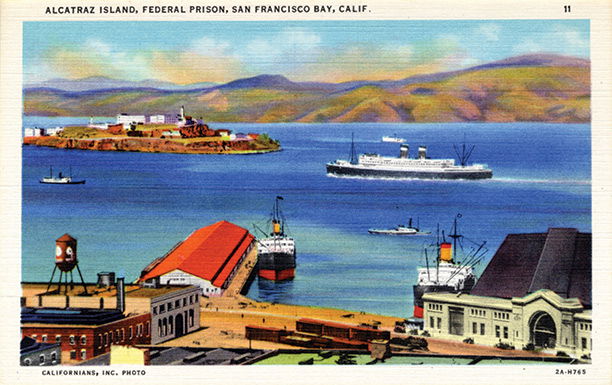Alcatraz Prison Closes
The notorious prison was closed for good on 21 March 1963.
 What was once one of the world’s most feared prisons, grimly isolated on a small island in San Francisco Bay, is now a popular tourist attraction. The first European to explore the area, the Spaniard Juan Manuel de Ayala in 1775, named the island Isla de los Alcatraces, usually translated ‘island of the pelicans’, which became Alcatraz in English. In the 1850s the United States army built a fortress there, to protect San Francisco, but it was never needed and in 1868 it became a military prison. In 1909 most of the original fortress was demolished and a new prison was built, which became known as ‘The Rock’. The work was done by the prisoners themselves.
What was once one of the world’s most feared prisons, grimly isolated on a small island in San Francisco Bay, is now a popular tourist attraction. The first European to explore the area, the Spaniard Juan Manuel de Ayala in 1775, named the island Isla de los Alcatraces, usually translated ‘island of the pelicans’, which became Alcatraz in English. In the 1850s the United States army built a fortress there, to protect San Francisco, but it was never needed and in 1868 it became a military prison. In 1909 most of the original fortress was demolished and a new prison was built, which became known as ‘The Rock’. The work was done by the prisoners themselves.
In 1933, because escape from it was considered impossible, Alcatraz was taken over by the US government and turned into a federal penitentiary for civilian convicts thought especially dangerous. The first batch of them arrived the following year, in handcuffs and guarded by a force of FBI agents and US marshals. The first warden was James A. Johnston, who ruled the institution with an iron fist until 1948. Strict silence was maintained most of the time and radios and newspapers were forbidden.
The prison had 150 or so staff initially and they and their families lived on the island. At any one time there were usually about 250 prisoners, living one to each tiny cell, typically 9ft long by 5ft wide and 7ft high. The most famous of them all was the gangster Al Capone, from 1934 to 1939. George ‘Machine Gun’ Kelly, nicknamed after his favourite weapon, was at Alcatraz from 1942 to 1959 and Alvin ‘Creepy’ Karpis, a Public Enemy No1, from 1936 to 1962. Robert Stroud, the ‘birdman of Alcatraz’, a psychopathic murderer who had reared sparrows and canaries at Leavenworth Penitentiary in Kansas, was not allowed birds at Alcatraz in his time there from 1942 to 1959. During the years to 1963 there were 14 escape attempts involving 36 men, of whom 23 were caught, six were shot dead, two drowned and the remaining five were thought to have drowned, either in the bay or swept out to sea.
The prison was closed in 1963 by Robert F. Kennedy as attorney general because the cost of transporting food, water and other supplies to the island made it far more expensive than the other federal penitentiaries. A group of Native Americans claimed the island in 1969 and occupied it until they were driven out by federal marshals in 1971. It was included in the new Golden Gate Recreation Area the following year and opened to the public.